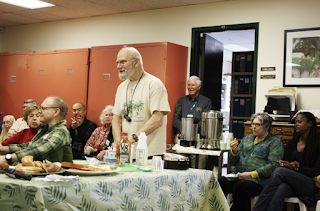 |
| Flowers of Lady's Bedstraw Image courtesy of John Crellin/ Floral Images http://www.floralimages.co.uk/ page.php?taxon=galium_verum,1 |
It's also one of the botanicals used in the 'Bird Cherry' expression of Byron's Gin, the official gin of the BSBI.
It certainly adds its unique honeyed taste and perfume to the gin but in centuries past, the flower was famous for three very different reasons!
Although the flowers are yellow, the tiny roots of Lady's Bedstraw were collected in bulk hundreds of years ago and were used to produce an orangey-red dye.
This was particularly prized in olden times when the only other source of a red dye was from lichen. Flora Celtica tells us that so much Lady's Bedstraw was collected from Hebridean machair in the 17th and 18th centuries that it exacerbated coastal erosion.
 |
| Lady's Bedstraw: leaves in a whorl Image courtesy of John Crellin/ Floral Images http://www.floralimages.co.uk/ page.php?taxon=galium_verum,1 |
It also used to be used in cheese-making, as a kind of herbal rennet. The 16th century herbalist John Gerard tells us that cheeses made in Cheshire and Gloucestershire were prized for the rich colour and pleasant taste imparted by Lady's Bedstraw.
And in case you wondered about the name 'bedstraw' - in medieval times, Lady's Bedstraw was used to stuff mattresses, because it was reputed to deter fleas and also because of the pleasant smell. There are also legends in Norse and Christian mythology about women giving birth on mattresses of Lady's bedstraw.
You can recognise this plant quite easily: like all its relatives in the Bedstraw family (Rubiaceae) found in the UK and Ireland, the leaves are arranged in a whorl around the stem.
There are only two members of the Bedstraw family in these islands which have yellow flowers: Crosswort, which has four bright green broad leaves in a whorl, and Lady's Bedstraw which has six or more narrow dark green leaves in a whorl. This combination of characters makes the plant easy to identify, even if you're just getting started with plant ID.
 |
| A stand of Lady's Bedstraw Image courtesy of John Crellin/ Floral Images http://www.floralimages.co.uk/ page.php?taxon=galium_verum,1 |
But if you've been following these monthly blogposts about Byron's Gin, you won't be surprised to hear once again that for every bottle sold of Byron's Gin, a donation is made to BSBI's Training programme which supports botanists studying wildflowers in Britain and Ireland.
Next week we feature a report from one of those botanists about the course she was able to take thanks to a BSBI Training Grant - watch this space!






















